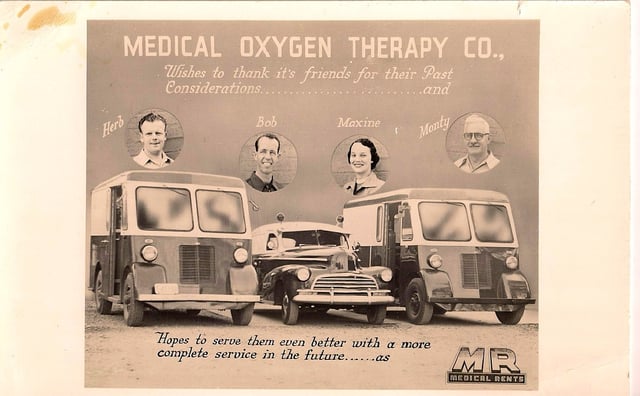 Fed Ex, UPS, and the US Postal Service have consistent, easily identifiable, and even iconic delivery vehicles. Pizza delivery vehicles often sport magnetic signs and/or rooftop billboards identifying the vehicle as part of their organization. And who hasn’t seen an Edible Arrangements truck cruising down the highway? This “branding” serves several useful purposes including marketing an organization. Delivery vehicles have been part of home medical equipment services since the inception of the industry. Be it a large truck from an industrial gas company, a cargo van, open pickup truck, or even a small, gas efficient compact car, delivery vehicles are an integral part of any DME organization.
Fed Ex, UPS, and the US Postal Service have consistent, easily identifiable, and even iconic delivery vehicles. Pizza delivery vehicles often sport magnetic signs and/or rooftop billboards identifying the vehicle as part of their organization. And who hasn’t seen an Edible Arrangements truck cruising down the highway? This “branding” serves several useful purposes including marketing an organization. Delivery vehicles have been part of home medical equipment services since the inception of the industry. Be it a large truck from an industrial gas company, a cargo van, open pickup truck, or even a small, gas efficient compact car, delivery vehicles are an integral part of any DME organization.
So, no one should be surprised to find out that surveyors will most likely spend substantial survey time and energy looking at your organization’s delivery vehicles.
Accreditation standards with regards to delivery vehicles are fairly straightforward. Like many of the standards, they are based on law and regulation first and foremost. They are also based on your organization’s policies and procedures. HQAA standards in the delivery module cover topics that include:
- The concept that all deliveries are documented with client information, type of equipment and supplies delivered, and other information required by law or payer requirement. It is also important that this information is protected and kept confidential at all times – including during delivery.
- Deliveries are done in a manner that are safe and follow appropriate infection control practices. Primarily, this means that equipment is secured during delivery and that clean, patient ready equipment and supplies are properly separated from dirty and used equipment being returned.
- An organization’s delivery process should include some kind of home safety assessment and teaching. The level of that assessment and teaching varies with types of equipment being delivered.
- Vehicles are maintained in good working order, are roadworthy, organized, and contain safety equipment and supplies.
- Signage is present on vehicles as required by law (placarding on appropriate oxygen delivery vehicles, for instance).
Your organization should have a policy on delivery vehicles that ensures consistency from vehicle to vehicle. The policy should list the items that each delivery vehicle should carry at all times. Typically, this includes items such as first aid kits, personal protective gear such as masks and gloves, hand wash solution, fire extinguishers, and road hazard supplies. The policy can also contain maintenance intervals and explain how documentation will be recorded.
Delivery process should include careful, accurate, and complete documentation of each delivery. Pay attention to law and regulation relating to commercial delivery vehicles, particularly if you have placarded oxygen. Oxygen delivery is fairly straightforward in terms of regulation, but know that if you are going to have more than 1000 lbs. of oxygen in your vehicle, it must be placarded (essentially special signage required by the Department of Transportation) and you must ensure that you are compliant with DOT regulations.
Any item you are delivering should be secured during transport. This is important for the safety of the delivery staff and also to protect your organization’s equipment and supplies. “Tie downs” should be safe and appropriate for the equipment you are delivering. In general, you should avoid the use of rubber “bungees” which have inherent safety problems.
Finally, when picking up used equipment from a patient’s home, make sure that your staff has a consistent process to separate clean, patient ready equipment and supplies from the contaminated, used equipment being returned. Barriers such as bagging equipment and physically separating the space for the equipment should be described in policy and that policy should be adhered to during delivery.
A very effective best practice for ensuring compliance with these standards is to inspect vehicles on a regular basis. This can be done by supervisory staff, managers, or the person responsible for quality/performance improvement within your organization. Perform these inspections on a regular basis—not just in preparation for survey. Also, perform these inspections at random intervals “unannounced” to ensure compliance at all times.
Use this checklist as a handy guide, but be sure to modify it to make sure it covers items your individual organization might require:
- Is the delivery vehicle clean and orderly?
- Audit the maintenance records. Is maintenance being performed at timely intervals?
- Is the delivery vehicle supplied with personal protective equipment (PPE)?
- Is there a first aid kit in the vehicle?
- Is there a fire extinguisher in the vehicle?
- Is there hand wash solution in the vehicle?
- Is the process for separating clean and dirty equipment being followed?
- Is equipment secured during delivery?
- Does staff have the proper delivery documents and paperwork present during delivery?



